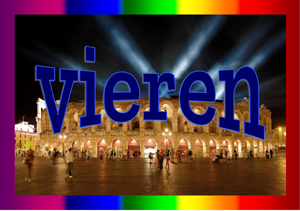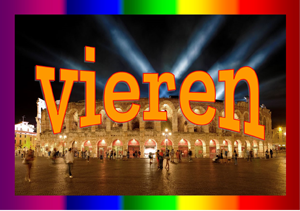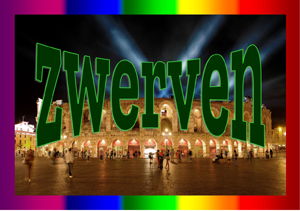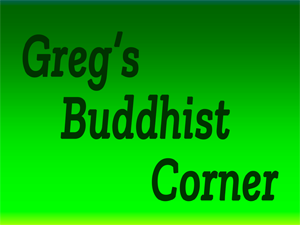By Greg Suffanti
Quest for Wisdom, April 2019
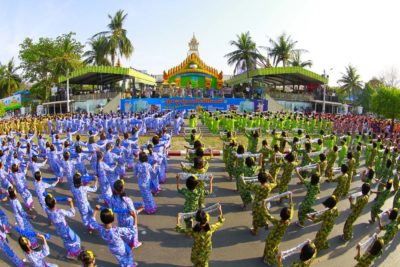
For a number of Southeast Asian lands where Theravada Buddhism is the dominant religion, April is not only the hottest month of the year, it is the end of one lunisolar calendar year and the beginning of another. Traditionally, the New Year celebrations take place on the first full moon day in April. This year, 19 April marks the start of the new year. However, through the centuries there have been many cultural influences on the holiday, both regional and national, and so, even the day or days in which the event takes place vary as well, sometimes varying within one country.
Water represents purity in Buddhism
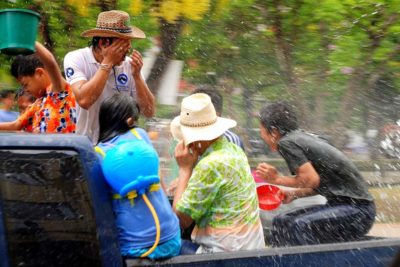
If you live in Thailand for example, then you will celebrate the New Year every year between 13-15 April, with observance days stretching to as long as a week in some parts of the country. In Myanmar, the New Year festivities take place between the 13th and 16th of April[2]. April is also the end of the dry season, so perhaps not surprisingly, water features prominently in welcoming in both the New Year as well as the rainy season. Water in Buddhism represents purity and water is symbolically used in ‘washing’ away one’s sins, as well as cleaning homes, statues and temples to welcome in the New Year afresh.
Theravada Buddhists, who use the Pali canon of Buddhist scriptures, which are the oldest such recorded sutras in existence, celebrate the new year in both traditional ways, such as making offerings to the monastic community, washing elders and Buddhist statues, as well as in more contemporary ways like the famous water ‘fights’ of Thailand.
Places like Thailand and Myanmar are famous for their ‘water fights’ during the New Year
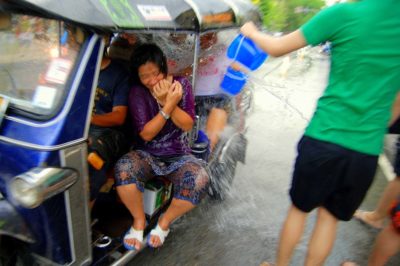
The New Year celebrations are both community and family centered. In 2018 the Thai cabinet extended the holiday to five days to allow people to visit their families. In 2019, the celebrated water fights on Khaosum Road in Bangkok have been cancelled due to King Vajiralongkorn’s coronation on 4 May[5].
Thailand, and increasingly Myanmar, are major tourist destinations at this time of year, as people flock to cities for the multi-day street parties, live music, traditional songs, colorful floats, parades, local foods, and of course, water fights.
Theravada Buddhist countries include Cambodia, Laos, Myanmar & Thailand
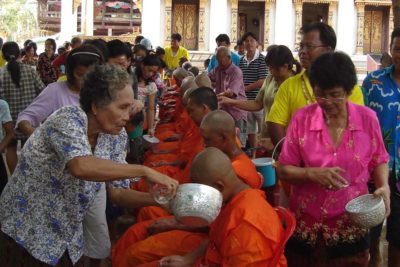
Theravada Buddhism is the predominant religion of Cambodia, Laos, Myanmar, Sri Lanka and Thailand. However, Theravada Buddhism is also practiced in India, Bangladesh, Nepal, Malaysia, China, Vietnam, and of course the West, which includes millions more followers. Theravada Buddhism most closely follows the teachings of the historical Buddha Shakyamuni, and seeks individual liberation from the cycle of birth and death, reaching the state of Nirvana, as the ultimate goal. The other main school of Buddhism, Mahayana Buddhism, is concerned with the liberation of all living beings, and relies on both the historical teachings of the Buddha as well as extensive commentaries and various interpretations of the teachings themselves. The ultimate goal of Mahayana Buddhism is to attain enlightenment for the benefit of all beings. Mahayana Buddhist countries include Tibet, Mongolia, Bhutan, Malaysia, Nepal, Singapore, Japan and China.
The Theravada New Year is known by a number of different names [7]:
- Chaul Chnam Kmer in Cambodia
- Lao New Year in Laos
- Sinhalese New Year in Sri Lanka
- Songkran in Thailand
- Thingyan in Myanmar
- Sangken in India
- Water Sprinkling Festival in China
In Myanmar the New Year holiday is better known as the Water Festival
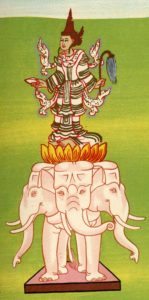
In Myanmar, the three day holiday is better known as the Water Festival. The origin of the holiday can be traced to an ancient Hindu myth, now given a Buddhist twist to suit a Buddhist land. According to legend, Arsi, the king of the Brahmins, challenged Sakra, king of the devas, and lost the wager. As per their agreement, Sakra then decapitated Arsi, placing an elephants head on his body. At this point, Arsi became the powerful deity Ganesha. Ganesha was so powerful, that if his head were placed in the ocean it would dry up. If the head was placed on the earth, it would also dry up. In order to protect all beings, Sakra decreed that henceforth a Devi princess would always carry the head, taking turns that lasted exactly one year. And thus the New Year has come to represent a symbolic changing of the guards of the Brahmin’s head[9].
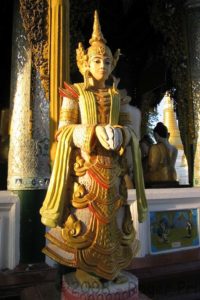
Day One of the three day festival is called ‘a-kyo nei’, and is an ‘uposatha day’, meaning a Buddhist holy day of observance since the time of the Buddha. The Buddha taught that uposatha days were “for cleansing the defiled mind”[11]. It is customary on these days to take one day lay vows, called precepts, and to refrain from such things as killing and stealing. It is also customary on this day to wash holy statues at temples, and for the young to wash the oldest of the community. Girls wear fragrant Padauk flowers in their hair. Padauk flowers blooming only one day per year, during Thingyan, and thus the flowers are also known as ‘Thingyan flowers’[12].
Day Two of Thingyan is called ‘a-kya nei’, and there is a festival atmosphere on the streets, which are filled with colorful floats, live music, local foods and thousands of people ‘cleansing’ each other in playful water ‘fights’. In the Burmeese capital, Yangon, there are even temporary water-spraying stations set up. It is said that on this day, Thagyamin, the king of the devas, comes down to earth from the heavens. Children are told that if they’ve been good, their names will in Thagyamin’s Golden Book; but, if they’ve been bad, their names will go in his Dog Book[12].
Day Three of Thingyan is called ‘a-kyat nei’. In certain years there are fourth days as well called ‘a-tet nei’. It is traditionally said that on the last day of the festival Thagyamin goes back to the heavens. The following day is New Year’s Day, ‘hnit hsan ta yet nei’, a day in which resolutions for the New Year are made, and positive actions are cultivated, like releasing captured fish and giving food donations, called ‘satuditha’, to monastics and those participating in Thingyan. During this period it is also traditional for ‘shinbu’ to take place, when novitiation ceremonies are held for aspiring monastics[12].
In China the Dai people’s New Year is called the Water Sprinkling Festival
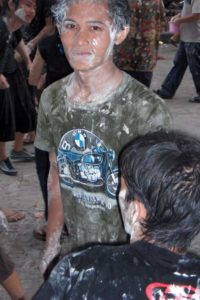
In China, the Dai ethnic minority celebrate the New Year at the same time as their neighbors in Laos, but rather than Songkran, the event is called the Water Splashing Festival. The Chinese celebrations also last three days, sometimes seven, and there are boat races on the first day, water dousing on the second day, and gift giving on the third day. The Dai Water Festival attracts thousands of tourists each year from all over China drawn to the music, song, dance and water dousing in Yunnan Province in Southwest China[14].
So, weather it’s Songkran or Thingyan or Water Sprinkling Festival, April marks the start of a new year for millions of Theravada Buddhists around the world.
Happy New Year from the Wisdomweb!
Notes
[1] Source: Young students wear Burmese dress and perform traditional dance during rehearsal for the opening ceremony of Mandalay City Hall Thingyan
[2] https://publicholidays.asia.com
[3] Source: Water fights, Chiang Mai
[4] Source: People in a tuk-tuk getting soaked during Songkran, Chiang Mai
[5] https://time.com/5564106/thailand-songkran-khaosan-road-king-coronation
[6] Source: Monks receiving blessing
[7] https://en.wikipedia.org/wiki/Buddhist_calendar
[8] Source: Thagyamin nat (spirit), th in the official pantheon of Burmese nats
[9] https://www.aziatischekunst.com/nieuws/birmees-waterfestival
[10] Source: Statue of Thagyamin, Lord of the Nats at Shwedagon Pagoda, Yangon
[11] https://en.wikipedia.org/wiki/uposatha
[12] https://en.wikipedia.org/wiki/Thingyan
[13] Source: The use of chalk is also very common having originated in the chalk used by monks to mark blessings
[14] https://en.wikipedia.org/wiki/water_festival

